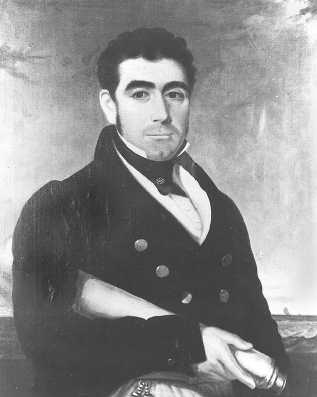| |
MacDonough (fig. 2-8) was everywhere during
the battle, trying to instill organization and
fighting spirit into his crew. His calm determina-
tion was remarkably contagious. The credit of this
victory against a superior force belongs first and
last to MacDonough himself. In choosing a
position that imposed upon the British an
approach under a raking fire, he won the opening
gambit of the battle. Meantime, he was wise
enough to hold several tactical tricks in reserve.
With these he managed to rally when the enemy
thought him beaten.
MacDonough’s Champlain victory was an
example of the American naval effort in the War of
1812. Pitted against the greatest naval power in
the world, our tiny Navy fought with great valor.
In accomplishing much with little, the Navy began
another tradition—one expressed by the Navy’s
slogan in World War II: “We must all do all that
we can with what we have.”
THE CIVIL WAR
SIGNIFICANT DATES
26 Jun. 1861 Commander James Harmon Ward
killed by musket ball— first Union
naval officer to become casualty in
Civil War.
16 Jul. 1862
Rank of rear admiral created;
David G. Farragut appointed as
first to hold rank.
11 May 1865 Confederate navy surrenders to
Captain Edward Simpson.
25 Jul. 1866
David G. Farragut appointed first
admiral in U.S. Navy.
The naval history of the Civil War vividly
portrays the use of sea forces against an enemy
who was economically dependent on shipping. The
Confederate States were a combined land power
with the advantage of interior lines. The
Confederates’ many sea and river ports allowed
them access to world commerce, which they vitally
needed; but an effective Union blockade denied
them war imports. The Confederates achieved
their successes with shoestring resources, which
were soon expended.
The Union navy (U.S. Navy) simultaneously
assumed three huge strategic tasks, largely
amphibious in nature. It attempted to blockade
the whole southern coast, force its way into
various southern ports, and cooperate with the
Union army on the Mississippi front. Union naval
forces were also called upon to protect northern
134.11
Figure 2-8.-The greatest naval victory of the
War of 1812, perhaps the most decisive of
all battles fought on land or sea in that
conflict, was won by Captain Thomas
MacDonough, “the hero of Lake
Champlain. ” The action halted a British
invasion of New York that stood little
chance of defeat at the hands of the
American army.
shipping from enemy raiders. The Union navy’s
ability to adjust to new conditions is shown in the
way it met the complex demands of the Civil War
both afloat and ashore. To complicate matters,
naval warfare at that time was in a transitional
period; that is, a total naval revolution was in
progress. Although steam propulsion was in-
troduced earlier, armor was just coming into use.
In the field of ordnance, rifled guns and shell
ammunition required new methods of fire control.
Produced by this rapid transition was one of
the oddest assortments of warships ever
assembled. The Union fleet contained old wooden
frigates like the Constitution, converted East
River ferryboats, scores of armed steamers, and a
number of experimental ironclads. The South used
armored vessels, steam commerce raiders,
electrical mines, and even primitive submarines.
Under the superior leadership of Secretary of
the Navy Gideon Welles and Assistant Secretary
Gustavus V. Fox, the Union navy used the war as
a testing period for strategies and weaponry.
2-11
|

